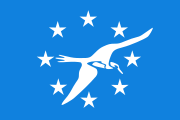Texas State Aquarium
 The Texas State Aquarium | |
| Date opened | July 6, 1990[1] |
|---|---|
| Location | Corpus Christi, Texas, United States |
| Coordinates | 27°48′50″N 97°23′32″W / 27.81389°N 97.39222°WCoordinates: 27°48′50″N 97°23′32″W / 27.81389°N 97.39222°W |
| Land area | 6.3 acres (2.5 ha)[2] |
| Volume of largest tank | 400,000 US gal (1,500,000 l) |
| Memberships | AZA[3] |
| Website | texasstateaquarium.org |
The Texas State Aquarium is a nonprofit aquarium located in Corpus Christi, Texas, United States. It is dedicated to promoting environmental conservation and rehabilitation of the wildlife of the Gulf of Mexico. It has been accredited by the Association of Zoos and Aquariums (AZA) since 1995.
History
Originally conceived by a coalition led by the Junior League of Corpus Christi and named the Gulf Coast Zoological and Botanical Society, the organization changed its name to the Corpus Christi Aquarium Association in 1978, and then to Texas State Aquarium Association in 1986 after the Texas State Legislature designated it the "Official Aquarium of Texas", although it would receive no state dollars.[2]
After more than 20 years of fundraising, planning, and building, the Texas State Aquarium opened its first exhibit to the public on July 6, 1990. In 1993, the aquarium became a federally permitted animal rehabilitation facility, and in 1995, it was accredited by the Association of Zoos and Aquariums (AZA).[2]
The current director and chief executive officer of the aquarium is Tom Schmid.[4]
Exhibits
- Dolphin Bay
This 400,000-US-gallon (1,500,000 l) saltwater exhibit houses four Atlantic bottlenose dolphins: Liko, Schooner, Shadow and Kai. The Atlantic dolphins put on an educational dolphin presentation, two to three times per day (depending on the season), so that visitors may speak with trainers about how trainers interact with their dolphins as well as learn more about how to conserve and protect the world's oceans.
- Eagle Pass
All of the raptors featured in this exhibit were rehabilitated at the Texas State Aquarium and cannot be released back into the wild. This exhibit includes a bald eagle named Grace.
- Floating Phantoms
This 800-US-gallon (3,000 l) exhibit contains a variety of jellyfish and sea nettle, most of which can be found in the Gulf of Mexico.
- Flower Gardens
Replicating a coral reef, this 40,000-US-gallon (150,000 l) exhibit features Atlantic tarpon, green moray eels, and cownose stingrays. The aquarium's "Diver in the Water" show takes place in this exhibit.
- Hawn Wild Flight Theater
These presentations feature a variety of trained birds including parrots, hawks, owls, and falcons. The Hawn Wild Flight Theater honors the Hawn family for their long-standing commitment to the aquarium's mission of wildlife education and conservation in South Texas. The theater was opened April 24, 2007.
- Islands of Steel
The largest indoor exhibit at the aquarium, Islands of Steel recreates the habitat formed around an oil platform. The 125,000-US-gallon (470,000 l) exhibit includes nurse sharks, amberjack, Atlantic tarpon, grouper, a barracuda, a sand tiger shark, and many other species that could be found in a naturally occurring habitat in the Gulf of Mexico.
- Living Shores
Visitors can interact with hermit crabs, lightning whelks, and pencil urchins that reside in several touch pools at this exhibit.
- Otter Creek
Four North American river otters reside at the aquarium and can be viewed interacting with one another and their trainers throughout the day.
- Saving Sharks
Saving Sharks is an interactive, informative exhibition designed to capture the hearts and minds of would-be conservationists and lifelong shark fans, alike.
- Stingray Lagoon
Visitors can touch Atlantic and cownose stingrays in the aquarium's largest outdoor touch pool.
- Swamp Tales
Bo, a 10.5-foot (3.2 m) American alligator, and six species of freshwater turtles and tortoises reside in the newest exhibit at the aquarium.
- Tortuga Cay
Visitors can view the rehabilitated and unreleasable sea turtles above and below the water at this exhibit. Tortugay Cay includes three green sea turtles (Squirt, Pickles, and Crush), one kemp's ridley sea turtle (Daisy), one hawksbill sea turtle (Hemingway), and a loggerhead sea turtle (Tiki).
Programs
In addition to regular tours, the Texas State Aquarium offers many other educational programs.[5]
- Aquarium Discovery Programs
Aquarium Discover Programs allow schools to bring their students to learn about the Gulf of Mexico environment.
- Aquavision – Distance Learning
For schools that are not able to tour the aquarium, Aquavision uses web-based and videoconferencing technology to provide access to the animals and staff of the aquarium. Learning objectives are aligned with the Texas Education Knowledge and Skills (TEKS).
- Overnights
Overnights allow children to spend the night at the aquarium where they can experience behind-the-scene tours of the aquarium.
- Outreach Programs
Outreach programs allow staff members to come to schools and give presentations in the classroom.
- Spring Break Camp
Spring Break Camp is designed to promote STEM exploration and discovery. Activities include paddleboating and canoeing at our SeaLab facility
- Summer SeaCamp
SeaCamp is a weeklong camp to promote STEM exploration and discovery. Activities include fishing, aquarium visits, field activities, chatting with an ocean scientist, tracking a shark, and an overnight stay at the aquarium.
On television
The aquarium appears in the pilot episode of JAG, when Harmon Rabb Jr. has a flashback of when he was with his father as a child on board an aircraft carrier (the USS Lexington Museum is located nearby).
References
- ↑ The Handbook of Texas Online: Texas State Aquarium
- 1 2 3 "History". texasstateaquarium.org. Texas State Aquarium. Retrieved 31 July 2011.
- ↑ "List of Accredited Zoos and Aquariums". aza.org. AZA. Retrieved 21 February 2011.
- ↑ The Loop: Under-Whelming
- ↑ "Texas State Aquarium: Education". Retrieved 16 August 2015.
External links
| Wikimedia Commons has media related to Texas State Aquarium. |
